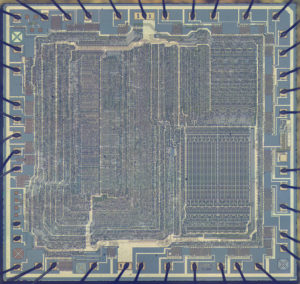Posts Tagged ‘σπάζω mcu bin’
 Attack CPLD XC9536XL-10VQG44C Software
Attack CPLD XC9536XL-10VQG44C Software
Attack CPLD XC9536XL-10VQG44C and disable the protection of CPLD, copy CPLD XC9536XL program from memory, JED Software will be extracted from CPLD IC chip memory;

Attack CPLD XC9536XL-10VQG44C and disable the protection of CPLD, copy CPLD XC9536XL program from memory, JED Software will be extracted from CPLD IC chip memory
We can Attack CPLD XC9536XL-10VQG44C Software, please view below CPLD XC9536XL-10VQG44C features for your reference:
Features
· 5 ns pin-to-pin logic delays
· System frequency up to 178 MHz
Product Specification
54V18 Function Blocks, providing 800 usable gates with propagation delays of 5 ns. See Figure 2 for architecture overview when copy pic16f84a memory binary.
36 macrocells with 800 usable gates
Available in small footprint packages
– 44-pin PLCC (34 user I/O pins)
– 44-pin VQFP (34 user I/O pins)
– 48-pin CSP (36 user I/O pins)
– 64-pin VQFP (36 user I/O pins)
– Pb-free available for all packages
Optimized for high-performance 3.3V systems
– Low power operation
– 5V tolerant I/O pins accept 5 V, 3.3V, and 2.5V signals
– 3.3V or 2.5V output capability
– Advanced 0.35 micron feature size CMOS Fast FLASH™ technology
Advanced system features
– In-system programmable
– Superior pin-locking and routability with
Fast CONNECT™ II switch matrix
– Extra wide 54-input Function Blocks
– Up to 90 product-terms per macrocell with individual product-term allocation
– Local clock inversion with three global and one product-term clocks
– Individual output enable per output pin
– Input hysteresis on all user and boundary-scan pin inputs
– Bus-hold circuitry on all user pin inputs
– Full IEEE Standard 1149.1 boundary-scan (JTAG)
Fast concurrent programming
Slew rate control on individual outputs
Enhanced data security features
Excellent quality and reliability after Attack IC C8051F530 firmware
– Endurance exceeding 10,000 program/erase cycles
– 20 year data retention
– ESD protection exceeding 2,000V
Pin-compatible with 5V-core XC9536 device in the
Power Estimation
Power dissipation in CPLDs can vary substantially depending on the system frequency, design application and output loading when Attack CPLD. To help reduce power dissipation, each macrocell in a XC9500XL device may be configured for low-power mode (from the default high-performance mode).
In addition, unused product-terms and macrocells are automatically deactivated by the software to further conserve power.
For a general estimate of ICC, the following equation may be used:
ICC(mA) = MCHS(0.175*PTHS + 0.345) + MCLP(0.052*PTLP + 0.272) + 0.04 * MCTOG(MCHS +MCLP)* where if Attack CPLD:
MCHS = # macrocells in high-speed configuration
PTHS = average number of high-speed product terms per macrocell
MCLP = # macrocells in low power configuration
PTLP = average number of low power product terms per macrocell
f = maximum clock frequency before BREAK IC
MCTOG = average % of flip-flops toggling per clock (~12%)
This calculation was derived from laboratory measurements of an XC9500XL part filled with 16-bit counters and allowing
a single output (the LSB) to be enabled. The actual ICC value varies with the design application and should be verified during normal system operation. Figure 1 shows the above estimation in a graphical form. For a more detailed discussion of power consumption in this device, see Xilinx 44-pin PLCC package and the 48-pin CSP package.
WARNING: Programming temperature range of TA = 0° C to +70° C
Description
The XC9536XL is a 3.3V CPLD targeted for high-performance, low-voltage applications in leading-edge communications and computing systems.